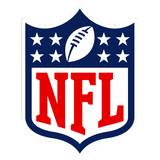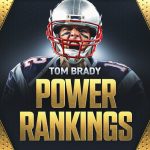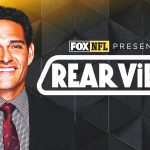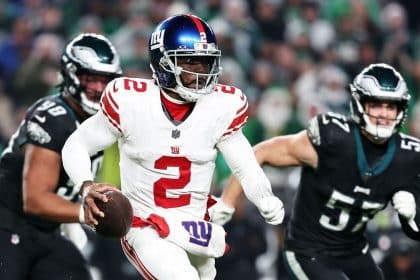Marcus Davenport was on his way to meet his best man for some day-before wedding preparations when he took a call from his new head coach Kevin O’Connell.
The Minnesota Vikings had just drafted Jordan Addison. Call it first-round privilege, but the rookie wide receiver had worn the No. 3 jersey his whole life. That was Davenport’s original pick upon signing with Minnesota as a free agent the previous month, but the sixth-year outside linebacker agreed to switch with his mind happily preoccupied with the impending nuptials.
All the numbers in the 90s were claimed, and Davenport was disinterested in negotiating a trade with — or putting pressure on — a teammate.
He then made the first of many wise decisions as a married man: He listened to his wife.
ADVERTISEMENT
“She was like, ‘Nobody has really ever had zero. Why don’t you be different? This is a new chapter, a new you,’” Davenport recalled in an interview after a recent practice with the Vikings. “I like to think of zero as a beginning and an ending, so I was like, ‘Let me just take this leap.’”
Davenport became the first player in purple to wear No. 0, of course, because this is the first season the NFL has allowed it.
The unusual number gets regular use in college football and in the NBA, but for an organization once derisively known as the “No Fun League,” this latest concession on uniform number rules was met with another warm welcome from the players. Two years ago, the NFL made several major changes including the allowance for every position except offensive linemen and defensive linemen to join the quarterbacks, punters and kickers in the prestigious single digits.
As of this week, 22 of the NFL’s 32 teams now have a zero hero. Seven are on offense: running backs Nyheim Hines (Bills, injured) and D’Andre Swift (Eagles) and wide receivers Braxton Berrios (Dolphins), Parris Campbell (Giants), Marvin Jones Jr. (Lions), Zach Pascal (Cardinals) and Calvin Ridley (Jaguars).
Including Davenport, there are 15 defensive players donning this smallest of the digits, perhaps a sign of attention-seeking in a sport that yields so much focus on and fame for the skill positions on the other side of the ball. The other edge rushers are Brian Burns (Panthers), Devin Bush (Seahawks), Lorenzo Carter (Falcons), Jonathan Cooper (Broncos), YaYa Diaby (Buccaneers), Roquan Smith (Ravens) and Byron Young (Rams). Rounding out the list are defensive backs Adrian Amos (Jets), Desmond King (Texans), Sean Murphy-Bunting (Titans), Greg Newsome (Browns), Ugo Umadi (Saints), Samuel Womack (49ers) and linebacker Daiyan Henley (Chargers).
The only players excluded from wearing No. 0 are offensive linemen, still limited to 50-79, and defensive linemen, still slotted between 50-79 and 90-99.
Bush encountered the same situation as Davenport after the Seahawks drafted a wide receiver in the first round in Jaxon Smith-Njigba who wanted his old No. 11.
“I was like, ‘All right, it’s fine,'” Bush said. “You get drafted once, so I gave up the number. I didn’t tax him. I didn’t charge him. So he’s lucky. But they end up having zero open, and I was like, ‘Why not?’”
Some of the decisions were more benign. Pascal wanted to stay with a single digit after moving from the Eagles to the Cardinals and discovered zero as his only option.
Jones, who returned to the Lions for the second time after playing the last two seasons for the Jaguars, picked zero at the urging of his children.
“I just said yes,” Jones said. “I couldn’t think of anything.’’
Davenport’s wife, Alexandra, was onto something with the new beginning. Murphy-Bunting switched teams, too, from the Buccaneers to the Titans.
“New situation, a new environment, why not start fresh?” said Murphy-Bunting, who would have stayed with the No. 26 he wore with Tampa Bay but found it already taken by teammate Kristian Fulton.
Henley, the Chargers rookie, wore No. 10 in high school and No. 11 and No. 1 in college.
“I feel it’s an opportunity to be remembered,” Henley said. “Obviously to want to be a good player is amazing, but to be the first good player in that number is even better. So I look at it as another opportunity to set the bar.”
Carter, who gave his old No. 9 to quarterback Desmond Ridder, found audial symmetry in the zero with his nickname, “Zo.” He wore No. 7 in college at Georgia.
“As a rookie I got stuck with 95 or 59. I took 59,” Carter said. “I wasn’t a huge number guy, but it was great to get a chance to get back in that single digit.”
Ridder took No. 4 as a rookie with the Falcons. Carter denied his request for No. 9 last year.
“But he came out there, and he made some plays, and he earned his job,” Carter said.
Ridley, for the record, actually sees himself wearing the letter ‘O’ — not the No. 0. He was one of the first players to announce his decision. His middle name is Orin, hence the inspiration.
“They call me ‘Original’ where I’m from,” said Ridley, who’s in his first season with the Jaguars after serving a year-long suspension from the NFL for gambling on games. “I’m original. I’m the first one. I wanted to be the first one to get it for sure.”
Davenport considered No. 11, as a representation of the two first-round draft picks the Saints sent to the Packers to move up 13 spots in 2018 and take him out of Texas-San Antonio.
“For a while, I took a lot of that pressure on myself,” Davenport said. “That probably hindered me.”
Now he can look down at his jersey number and feel free — and special.
“I think it intrigues more fans,” Bush said. “To see a linebacker wearing zero, you’re not going to forget it.”
Reporting by The Associated Press.
NFL trending

Get more from National Football League Follow your favorites to get information about games, news and more











